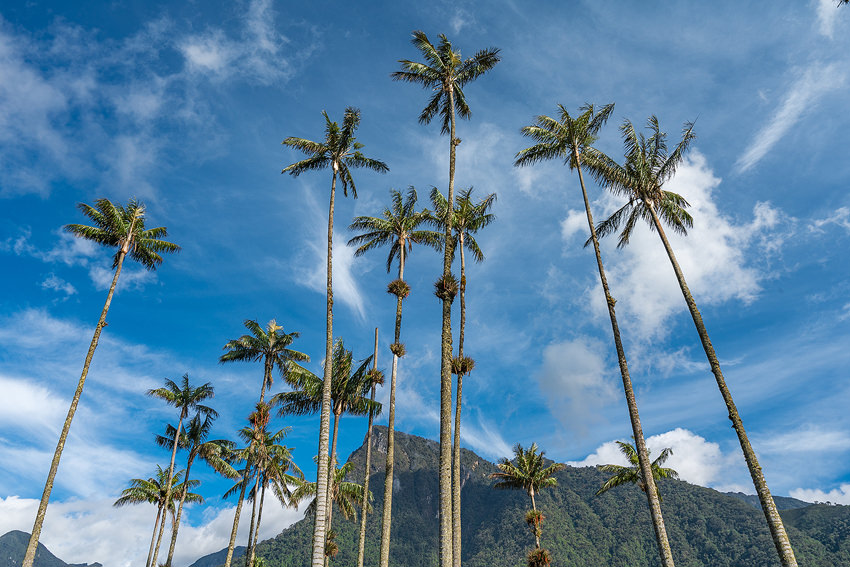
Walking Amongst Giants In Valle De Cocora
Standing in the Valle de Cocora with my head tilted back and the sun in my eyes looking towards the heavens; my mind couldn’t find the words. Was I really standing at the feet of the tallest palm trees in the world?
The Valle de Cocora or the Cocora valley lies in Los Nevados National Park in central Colombia. It boasts not only exquisite beauty but a world record as well. The wax palms that dot the steep green hills are one of Colombia’s national symbols and the tallest in the world.
Travelers come from far and wide to see the Quindio wax palms as well as to hike and camp into Parque Nacional Los Nevados; after all, that’s the reason I was there.
Getting To Valle De Cocora
Any excursion to see the tallest palm trees in the world will start from the nearby town of Salento; a sleepy pueblo in the heart of the Cafeteria aka coffee region of Colombia. Brightly painted post World War 2 era ‘Willy’ jeeps will be your transportation to Valle de Cocora. You can hitch a ride in one of these classic rides Colectivo style. That means cramming fifteen people into a vehicle that fits ten.
The first ‘Willy’ leaves at half past six in the morning from the main square in Salento and should cost 4,500 COP or $1.50 USD. They run every hour with the last one leaving Valle de Cocora at half past six in the evening.

The Colombian Countryside
After about half an hour in the back of the overloaded ‘Willy,’ you will reach a small string of shops and restaurants. This is your stop and the entrance to Valle de Cocora. From here you have a few options for hiking around the valley.
Option 1: A four-hour counter-clockwise walk through lush green pastures and dense jungle, as well as an uphill battle to a mountain estate, and a leisurely stroll through the central valley. It is the preferred direction of most travelers and mine as well.
Option 2: A four-hour clockwise loop with the same landscapes as option one, only this time in reverse.
This post will cover option one as it is; in my opinion; the better route. Hiking the Valle de Cocora loop counter-clockwise will entail a fun, exciting start through green pastures and dense jungle; ending with one granddaddy of a finish through the part of the park that they plaster on postcards.
So without further ado; here’s a guide to hiking through Valle de Cocora (without a guide of course).
Hiking Through Valle De Cocora
As you stand at the entrance of the park looking eastward, you will see a small dirt road directly ahead and a blue gate slightly off to your right. That gate is where you need to go to get to the start of the trail.
Travel Tip: Apparently there is a 3,000 COP or $1 USD entry fee to the valley, however, when I arrived at seven there were no guards taking money. So if that isn’t a big enough clue; go early.
That winding trail will lead you through lush open pastures dotted with the famous palms and occupied by some very curious bovine (cows) who seem to think that if they don’t move, you won’t see them.

Nobody Mooove

Valle de Cocora

Rio Quindio
Welcome To The Jungle

Rickety Wooden Bridges

Mountains In The Distance
After two hours of hiking through the lush green valley and dense jungle, you will finally arrive at the end of the first leg of the loop. A small unmarked crossing with a steep path on the left leading up to Finca la Montaña will mark your return.
If you fancy a little snack break and some high energy company, then the hummingbird sanctuary of Acaime is only a few more minutes down the trail.
Warning: The Acaeme sanctuary is the farthest you will want to venture if you don’t plan on hiking for another six hours into Parque Los Nevados. If you are worried about missing your turn-off, then I would suggest downloading an offline map so that you know exactly where you are at all times.

Entrance To Acaime Sanctuary

Wild Mountain Flowers
Finca La Montaña
Finca la Montaña or (the mountain estate) is a small complex at the top of one of the mountains in Valle de Cocora. They have a bar where you can top off your liquids and take a breather after that uphill battle you just had. If you’re the kind of person who likes to leave a mark on the places you’ve been, then they also have a guestbook you can sign.
Sitting at 9,383 feet (2,860 meters) above sea level, Finca la Montaña is a perfect spot to get a bird’s-eye view of Valle de Cocora.

Valley View From Finca La Montaña
The walk back to the entrance from Finca la Montaña is hands down the best part of the trek. It is why this entire post is about hiking option number one. The whole valley will be in front of you as you make your way along the ridge.
Travel Tip: I recommend going to Valle de Cocora in the early morning or late evening when the sun is just starting to cast its rays across the valley. There are also much fewer tourists during these off-peak hours.

Walking Amongst Giants
Thanks For Reading!!
Have you been to Valle de Cocora?
Did you become a tree hugger as I did?

